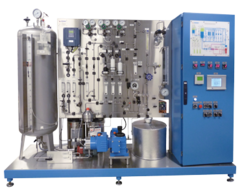Recirculation loops are used in laboratories to simulate a real-life operating environment for example in power plants, pipelines, steam turbines, deep sea applications, etc.
Test loops
They offer the following benefits:
- A large water volume reduces the effects of corrosion products on the water chemistry.
- Water can be regenerated in ion exchangers, UV-cell and filters.
- The dissolved oxygen and hydrogen concentrations, pH and conductivity can be monitored and controlled.
- Recirculation loops provide a reproducible and valid test environment that leads to reproducible and representative test results.
Loops simulating power-plant operation provide clean water with a specific water chemistry. Special attention is paid to the monitoring of both incoming and outgoing water flows and to the removal of water contaminants. An essential part of the operation is the control of the dissolved oxygen concentration and maintaining a low water conductivity in BWR and SCW applications.
Loops are used in oil and gas applications to provide a large water volume, which provides stable water chemistry during long test periods. Loops provide high H2S and CO2 partial pressures at high temperature because the gases are dissolved in the storage tank at low temperature. Loops are designed to resist corrosive H2S and CO2 gases. The construction materials is often Hastelloy C-276.
Cormet builds steam loops for high-pressure and sub-atmospheric pressure environments where they are used to simulate various kinds of situations in steam turbines. High speed loops are built for the simulation of the flow assisted corrosion and for the cooling of the heat exchangers or thermal fatigue specimens.











